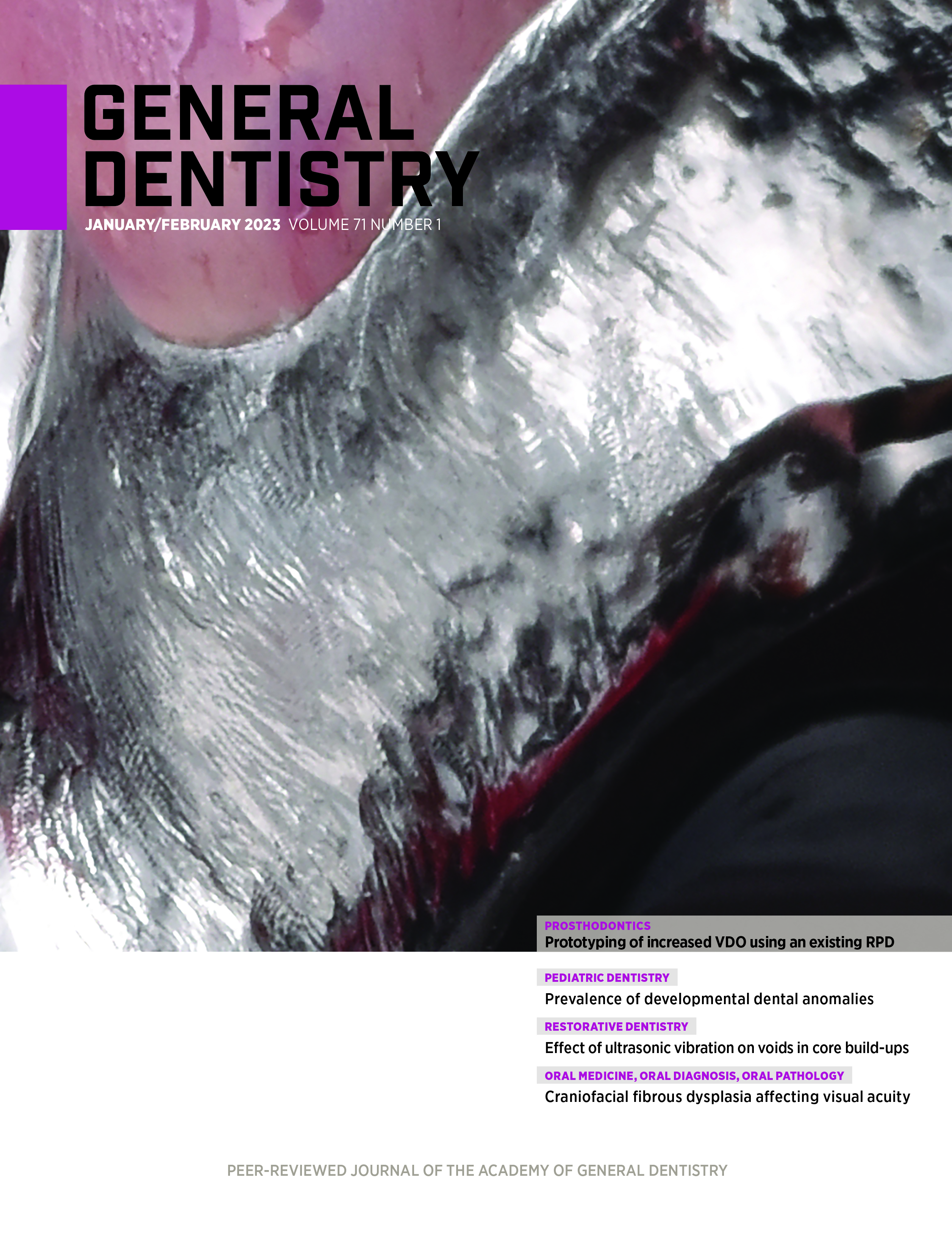-
SELF-INSTRUCTION
Pediatric Dentistry
The prevalence of developmental dental and eruption anomalies assessed using panoramic radiographs: a retrospective study
Brooks Hummel
Qingzhao Yu
John Frazier
Richard W. Ballard
Jeffrey T. Johnson
Paul C. Armbruster
Panoramic radiographs were evaluated to determine the prevalence of dental anomalies and developmental disturbances in a heterogenous patient population of 1042 orthodontic patients aged 10 to 18 years. There were no differences in prevalence based on the sex, Angle classification, or age of the patients. However, Black patients had a significantly greater prevalence of impactions, and Asian patients had a significantly greater prevalence of findings that could not be definitively diagnosed by panoramic radiograph alone.
2023 January/February; 71(1):19-23.
Full Article (PDF)
Self-Instruction Exercise No. GD504
-
Prosthodontics
Root-supported overdenture in a patient with a cleft palate and extensive bone loss after traumatic injury
Rodrigo Shinichi Takeshita
Victor Augusto Alves Bento
Daisilene Baena Castillo
This case report describes the use of palatoplasty and maxillary and mandibular complete overdentures with a ball attachment system supported by natural roots as rehabilitative treatment for a patient injured in an automobile accident. The treatment successfully reestablished chewing, phonetic, and esthetic functions at a lower cost than other options.
2023 January/February; 71(1):25-30.
Full Article (PDF)
-
SELF-INSTRUCTION
Restorative Dentistry
Effect of ultrasonic vibration on the presence of voids in core build-up materials
Wei Liu
Michael Rudmann
Stephen Yune
Richard Adcook
Nora Watson
Nicholas Hamlin
This study examined the effects of ultrasonic vibration during core build-up placement in glass ionomer and composite resin materials. Compared with specimens fabricated without vibration, specimens in the vibration group had more voids in both materials, but vibration was significantly associated with more severe voids only in the glass ionomer group. The application of ultrasonic vibration during placement of core build-up materials may not be clinically advantageous for improving restorative outcomes.
2023 January/February; 71(1):31-36.
Full Article (PDF)
Self-Instruction Exercise No. GD505
-
Practice Management
Dental patients’ communication preferences for learning about HPV-related topics
Heather Owens
Jason Beckstead
Kimberly Walker
Erika L. Thompson
Scott L. Tomar
Stacey Griner
Jill Desch
Ellen M. Daley
The aim of this study was to determine how dental patients prefer to learn about topics related to human papillomavirus, including the vaccine. The most preferred modality was one-on-one discussion with an oral healthcare provider, rather than electronic or print media, but the strength of this preference was significantly attenuated among patients who had previously discussed the subject with their dentist.
2023 January/February; 71(1):38-43.
Full Article (PDF)
-
Restorative Dentistry
Survival and success of composite resin restorations in endodontically treated maxillary incisors with minimal structure loss
Rahul B.
Anand Sherwood I.
Bennett T. Amaechi
Swathipriyadharshini S.
Gokulapriyan K.
Omar Farooq
Kamatchi Savadamoorthi Subramani
The primary aim of this study was to evaluate the clinical performance of a nanofilled composite resin restoration in traumatized, endodontically treated maxillary incisors with structural loss of 40% or less. The results showed that the direct composite resin restorations demonstrated acceptable survival and success rates over a period of 20 months.
2023 January/February; 71(1):44-49.
Full Article (PDF)
-
Oral Medicine, Oral Diagnosis, Oral Pathology
Severe craniofacial fibrous dysplasia associated with decreased visual acuity: a case report
Gabriely Franzoi
Natália Cristina Trentin Bordignon
Luiz Henrique Godoi Marola
Rogério Gondak
Fibrous dysplasia is a developmental abnormality characterized by the replacement of normal bone tissue by fibrous connective tissue with poorly organized bone trabeculae. This case report describes the treatment of an 18-year-old man who presented with complaints of facial deformity and decreased visual acuity caused by craniofacial fibrous dysplasia.
2023 January/February; 71(1):50-53.
Full Article (PDF)
-
Restorative Dentistry
Clinical protocol for intraoral repair of a chipped all-ceramic crown: a case report
Miguel A. Saravia-Rojas
Rocio Geng-Vivanco
A 59-year-old patient fractured her all-ceramic crown, revealing chipping and debonding of the feldspathic ceramic veneer and exposure of the zirconia framework. The fractured fragment was brought to the dental office, and the fragment was successfully used to repair the crown intraorally. The intraoral repair of a chipped all-ceramic crown is a conservative, low-cost alternative that allows for immediate restoration of function and esthetics.
2023 January/February; 71(1):54-57.
Full Article (PDF)
-
SELF-INSTRUCTION
Basic Science
Prevalence of second molar external root resorption caused by mandibular third molars: a CBCT study
Jhonatan Thiago Lacerda-Santos
Gélica Lima Granja
Patrícia Meira Bento
José Cadmo Wanderley Peregrino de Araújo-Filho
Daniela Pita de Melo
Jalber Almeida dos Santos
Assessment of cone beam computed tomograms revealed that the prevalence of mandibular second molar external root resorption caused by impacted third molars was high, especially in male patients. Mandibular third molars in the Pell and Gregory class IC position or Winter mesioangular position demonstrated greater potential to result in external root resorption of the adjacent second molar.
2023 January/February; 71(1):58-63.
Full Article (PDF)
Self-Instruction Exercise No. GD506
-
Oral and Maxillofacial Surgery
Clear aligners combined with orthognathic surgery: a case series
Sérgio Luis de Miranda
Marina Reis Oliveira
Adonai Peixoto Cheim Júnior
Roberto Moreno
Maria Victória de Freitas Miranda
Ricardo Luiz de Lima Barbosa
This article presents a case series of 16 patients who underwent orthognathic surgery with the adjunctive use of clear aligners. All patients were successfully treated, and none experienced complications or relapse during posttreatment follow-up periods of up to 10 years.
2023 January/February; 71(1):66-70.
Full Article (PDF)
-
Prosthodontics
Prototyping of increased vertical dimension of occlusion using an existing removable partial denture and composite resin: a case report
Kevin A. Shepherd
Jackie Janzen
William W. Brackett
Mario F. Romero
In partially edentulous patients, the concept of a bonded composite resin prototype for increasing the vertical dimension of occlusion (VDO) has previously been applied through the use of an overlay removable partial denture (RPD) with acrylic resin covering the existing dentition. This case report describes the direct bonding of an existing RPD to create a prototype for increased VDO in a partially edentulous patient with a skeletal Class II malocclusion.
2023 January/February; 71(1):72-76.
Full Article (PDF)

